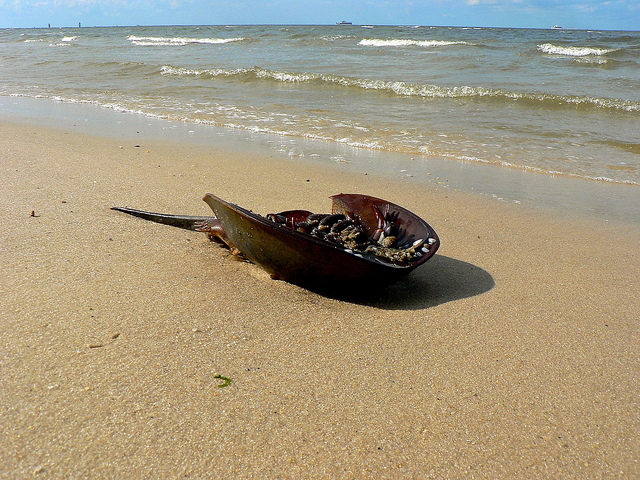Horseshoe crabs have existed for 450 million years, but only in the last few decades have the arthropods been prized for a peculiar part of their anatomy: their bluish-colored blood. In the 1970s, pharmaceutical companies began using a chemical found in the crabs’ blood to test whether new medicines were free of harmful bacteria. Today, the blue blood of the horseshoe crab is a hot commodity—a quart is worth up to $15,000.
The test takes advantage of the crabs’ natural defense mechanism. When the chemical comes into contact with dangerous bacterial endotoxins, it causes the blood to coagulate, slowing the spread of bacteria. Horseshoe crab blood, therefore, provides a straightforward and instantaneous way to test the safety of everything from new drugs to pacemakers to water.
The crabs live along the eastern coasts of North America and Asia. Each year, roughly half a million of them are captured, taken to labs, and turned into unwilling blood donors. Technicians use stainless steel needles to pierce the crabs’ soft underbodies and extract nearly a third of their blood. The animals are then released back into the wild, but the process takes its toll. Long-term effects of the bleeding aren’t completely understood, but conservation groups estimate that up to 30 percent of bled crabs perish after being released. Some research suggests that the practice could also lower the crabs’ spawning rates.
The effects reverberate throughout coastal ecosystems, notably for shorebirds that feed on the crab’s eggs. The red knot, a migratory bird listed as threatened under the Endangered Species Act, is of particular concern. The bird stops at the crab’s spawning grounds along the Delaware Bay and New Jersey coastline during its annual 10,000-mile migration from South America to the Arctic. Red knots consume so many horseshoe crab eggs and other invertebrates that they can practically double their bodyweight.
After more than a decade, an alternative to the blood-based test seems to be gaining traction in the biomedical community—and it could ultimately spare horseshoe crabs and bolster the species that depend on them. In May, pharmaceutical company Eli Lilly announced that it had replaced the old method based on crab bleeding with one that uses Factor C, a technology based on recombinant DNA, for testing water at two manufacturing sites. The synthetic alternative, known as rFC, was first introduced by Singapore researchers in 2001. But rFC’s big break never materialized due to a mix of concern over supplier bottlenecks and the molasses-like pace of the FDA approval process.
Revive and Restore, a California nonprofit, aims to propel rFC toward market acceptance. A recent paper released by the group surveyed 10 medical studies and determined the synthetic substance is both safe and effective as an alternative to horseshoe crab blood. Citing interviews with biomedical experts, the group claims that rFC has the potential to reduce use of the crabs’ blood by 90 percent.
While the new technique could hand a reprieve to the odd-looking crab, other innovations could one day help conserve scarce resources on a much wider scale. One example that has captured plenty of imaginations in Silicon Valley is “cultured meat”—essentially, animal protein raised in a lab rather than on a ranch. Many investors have also sunk funds into plant-based alternatives to meat. The most notable one may be the Impossible Burger, available at select coastal restaurants and known for being a fake burger that oozes “blood.” (Presumably not of the color blue.) If these sorts of technologies can truly break out of the lab and into the marketplace, they could take pressure off large amounts of cropland, forests, and other natural resources in the future.
Come what may, the mere potential of the not-a-burger burgers and rFC serve as a powerful reminder to conservationists: Sometimes the best way to spare nature is to look beyond statutes, restrictions, and regulation—and embrace technological innovation.




